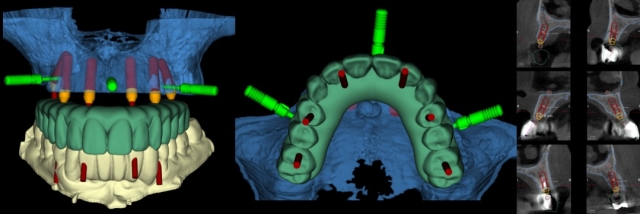Surgical Guide Classification for Full Arch Prosthesis (Part 1)
By Ricardo Mitrani on November 17, 2017 |It is well accepted in the literature that it is possible to achieve a high implant survival and success rate when dental implants are planned and placed properly. Nevertheless, it is important to understand that the concept of successful osseointegration of a dental implant does not necessarily relate to a restorative success. This means that we can have an implant that osseointegrates with its surrounding bone, but does not have optimal position/angulation to achieve proper restorative contours. These factors play a crucial role in the long-term predictability.
Surgical guides are great tools to assist in diagnosis and treatment planning. If used properly, they will allow proper positioning and angulation of the implants. With the evolution of new techniques, we now live in a “restorative-driven implant era,” and the use of digital planning and surgical guides can accomplish this purpose and decrease clinical and laboratory complications.
There are a number of different digital treatment planning software that allow the opportunity to position the implant digitally. Once it is positioned, some specific software create a digital surgical guide file that can be 3D printed or milled.


This guide will be used during the surgery to transfer the precise 3D implant position (position, angulation and depth). The glossary of prosthodontic terms defines the surgical template as a guide used to assist in proper surgical placement and angulation of dental implants.
The main advantages for a surgical guide are:
- Minimally invasive procedure - surgical guides allow minimal intervention by means of flapless/minimal flap implant placement that minimizes postoperative swelling.
- Precision - Implant placement is more accurate and decreases manual errors associated with free hand implant placement.
- Safety - Vital anatomic structures such as nerves, maxillary sinuses, adjacent teeth etc. can be avoided by utilizing a surgical guide properly.
- Predictability - The transfer of information from the digital platform to reality is very accurate, thus providing a very predictable final result.
- Esthetics - When using surgical guides, the implant 3D position will be very precise, thus providing adequate space for components/ceramics and a more esthetic result.
- Hygiene - Correct implant position allows proper restorative contours that will furnish proper oral health maintenance.
- Effectiveness - Reduction of implant surgery time and laboratory time.
- Ease in fabrication - With modern digital planning aids and implant planning software, it is very easy to design and fabricate the guides.
- Bone reduction guides - Special bone reduction guides can be used for a full arch prosthesis.
- Provisional prosthesis - Digital planning allows the possibility to fabricate a provisional prosthesis for immediate loading on terminal dentition/fully edentulous cases
The disadvantages for utilizing a surgical guide are:
- Modifications - Once the guides are fabricated, they do not allow any change or modification from the predetermined position if required at the time of surgery
- Precise fit - If the guide does not fit properly, it should not be used.
- Guide stabilization - If the guide is not properly stabilized, it can lead to dislocation during surgery and introduce error.
- Bending - Bending of the guide can occur when drilling into hard bone, producing torsional forces on the sleeves, thus lifting off the guide.
- Learning curve - There is a great learning curve included in the digital planning and design of the guides.
- Special equipment - Most implant companies sell a special guided surgery kit and guided implants, which results in a greater expense.
- Cost - In most countries, it is still expensive to acquire the software and fabricate the guides.
There are multiple classifications in the literature for surgical guides based on:
- The support of the surgical guides:
- Tooth supported, Bone supported, and Mucosa supported.
- Accessibility:
- Surgical guides can be open sleeve or closed sleeve.
- Utility:
- Pilot guides, complete drill guides, safe guides/easy guides.
- Material:
- Self/light cure acrylic resin, metal reinforced acrylic templates; vacuum formed polymers, milling, CAD-CAM prosthesis, stereolithographic models
We have developed a simple way of classifying the surgical guides based on our experience in clinical practice:

Analog fabricated:
- Restrictive flapless / open flap.
- Non-restrictive open flap.
CAD/CAM fabricated:
- Restrictive fully guided flapless.
- Restrictive fully guided open flap.
(Click this link to read more dental articles by Dr. Ricardo Mitrani.)
Ricardo Mitrani, D.D.S., M.S.D., Spear Faculty and Contributing Author
References:
- Umapathy T, Jayam C, Anila B S, Ashwini C P. Overview of surgical guides for implant therapy. J Dent Implant 2015;5:48-52
- D'Souza K, Aras M. Types of Implant Surgical Guides in Dentistry: A Review. JOI 2012;Vol XXXVIII-No. Five.
- The glossary of prosthodontic terms. J Prosthet Dent 2005;94:10-92.